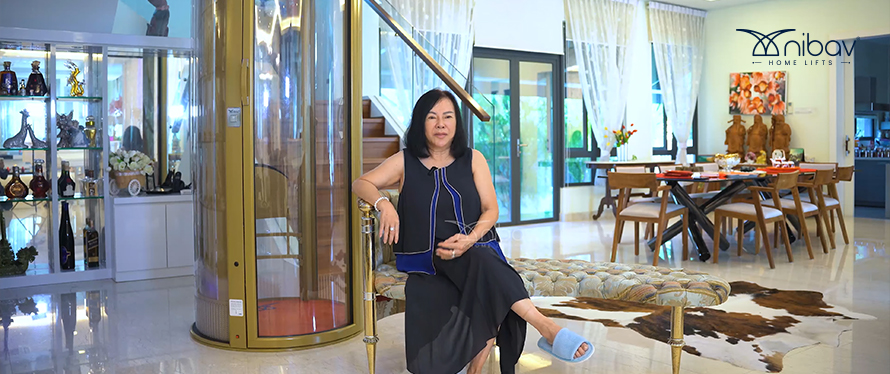Imagine the convenience and increased property value a modest lift or elevator could bring to your three-storey home. This is a practical solution for those with mobility challenges or senior family members and a way to make your home more functional and appealing.
Understanding the cost components of lift installation, such as the type of lift, customization options, and installation complexity, is important. This knowledge empowers homeowners to make informed decisions that balance their budgets with specific requirements.
Factors Influencing the Cost of Installing a Lift/Elevator
Size and Design of the Lift
The size of the elevator cabin significantly influences its pricing. A bigger cabin can seat more passengers, but it requires more materials, which raises both the buying and installation expenses. Some homeowners choose standard-sized elevators to decrease the costs, but others want customized cabins with vast amenities.
Additionally, design decisions influence cost variances. The entire cost may jump dramatically if you pick premium finishes like glass walls, panels, or high-end lighting. Choosing a design that fits your budget while meeting your aesthetic tastes offers an ideal combination of utility and affordability.
Type of Elevator
The type of elevator used affects the original cost and long-term costs such as maintenance and energy usage.
- Pneumatic Lifts: They are space-saving and use air pressure to travel between levels. They are also aesthetically beautiful and require a few structural adjustments, but they have an affordable initial cost compared to other choices.
- Hydraulic Lifts: These lifts are known for their strong lifting mechanism, which ensures a smooth and pleasant ride. However, because of their complicated engineering, they are more expensive upfront and require a specialized machine room, which increases installation expenses.
- Traction Lifts: These are energy-efficient and use less electricity. They function with counterweights, which makes them a fantastic choice for people looking for long-term cost reductions. However, installation can be a little more complicated.
Customization Options
Many homeowners like to incorporate bespoke components that complement their interior décor. Options such as glass doors, touchless control panels, and premium finishes such as advanced technology might raise the price significantly.
Additional features like voice-activated controls, emergency backup power, and smart home integration improve convenience but increase costs. Choosing standard models with critical features might result in substantial cost savings while preserving functionality.
Location and Installation Complexity
Prices are influenced by where the elevator installation takes place. Building a lift in a modified structure usually requires extensive work to strengthen walls and develop an appropriate shaft.
The price and installation process of building elevators in new constructions often proves more favorable because architects can allocate elevator space during building design. Other elements influencing installation costs include floor height, available space, and local construction requirements.
Average Range for a Simple Home Elevator Cost in 3-Storey Building
Price Breakdown Based on type and installation requirements.
The cost of building a home elevator varies depending on the lift type and advanced amenities chosen. Here’s a general cost breakdown:
- Nibav Pneumatic lift: AED AED 94505 to AED 127,305
- Traction lift: AED 98,000 to AED 140,000
- Hydraulic Lift: AED 99,000 to AED 150,000
General Cost Estimates for Residential Buildings
A home elevator cost in a 3-storey building usually starts from AED 94505. However, prices may rise due to increased customization, complicated installation requirements, or premium design options. When planning a house lift, homeowners must factor in upfront installation costs and long-term maintenance fees.
Additional Costs to Consider
Ongoing Maintenance and Service Charges
Regulatory service checks ensure operational safety and that elevator systems usually function. Steering lift service expenses depend on the size and ride frequency of the equipment.
Under service contract arrangements from certain manufacturers, homeowners receive scheduled equipment inspections, fast emergency repairs
Power Consumption and Energy Efficiency
Each elevator design requires a unique amount of power during operation. The hydraulic lift requires additional power from its hydraulic pump system to produce functional operations, so homeowners pay higher electric bills. Traction lifts reduce energy consumption through balanced movement using counterweight systems.
Nibav Pneumatic elevators can operate energy-efficiently backup power systems to function properly. Selecting energy-efficient products reduces operational costs, easing the financial burden.
Structural Modifications Required
Significant structural alterations may be required if a property lacks a pre-built elevator shaft, raising the cost. Older homes may also need extra reinforcements to support the lift, which increases the price. Before installation, homeowners should speak with specialists.
Why Choose Nibav Home Lifts 3-Storey Building
1. Advanced Air-Driven Technology for a Smooth Experience
Nibav house elevators use modern pneumatic vacuum technology to provide a smooth, silent ride. Unlike typical lifts, these elevators run on air pressure, avoiding the need for heavy cables and counterweights. This innovation not only improves riding comfort but also lowers long-term maintenance requirements.
2. Built-In Safety Features for Maximum Security
Nibav house lifts prioritize safety features to provide maximum security. These elevators come with essential safety measures, including:
- Emergency Descent System: Ensures the lift is safely lowered during a power outage.
- Battery Backup: The feature allows uninterrupted operation during power blackouts.
- Automatic Door Locking System: The Automatic Door Locking System activates automatically to stop elevator door openings during movement.
- Overload sensors: They detect extra weight and prevent harmful operations.
3. Space-Saving and No Need for a Machine Room
Nibav lifts’ most significant advantage is their small size. Unlike standard hydraulic or traction lifts, which require a machine room and significant structural modifications, Nibav lifts are self-contained. Their small size makes them perfect for households with limited space, making installation easier and less expensive.
4. Energy-Efficient Operations for Cost Savings
Nibav house elevators use substantially less electricity than hydraulic and traction lifts. Their pneumatic technology consumes less electricity while rising and zero power when descending, decreasing energy expenses over time. This environmentally friendly characteristic makes them a long-term choice for homeowners.
5. Affordable Installation with Long-Term Value
Nibav lifts provide an inexpensive alternative without sacrificing quality. The installation process is simple and eliminates the need for substantial changes. Their endurance offers low maintenance costs, making them an affordable long-term investment.
Conclusion
A simple residential lift installed in buildings with three levels enhances accessibility, creates convenience, and raises property value. The price of installing a lift depends on its dimensions and model type, as well as the design level and installation complexity.
Prices for these lifts range from AED 94505, but homeowners should account for maintenance costs and structural modifications. Nibav home lifts offer space-saving functionality and long-term advantages, such as minimal power consumption and extended functionality, while improving building attractiveness.
FAQs
1. How much does it cost to install a lift/elevator in a 3-storey home?
Product prices begin at AED 94505 and extend based on standard features and customization levels.
2. What are the maintenance costs for lifts in a 3-storey building?
The cost of yearly lift maintenance dependents varies according to the lift model and the chosen service provider.
3. Which is the best lift/elevator type for small 3-storey buildings?
Pneumatic elevators are suitable for small places, whereas traction lifts are energy-efficient. The most suitable alternative is determined by available space and money.
4. How can Nibav home lifts save space and costs for a 3-storey house?
Nibav lifts need little structural alterations, resulting in lower installation costs. Their small form and energy efficiency make them an affordable residential alternative.


